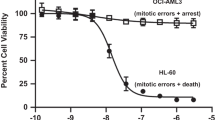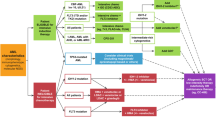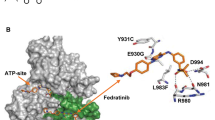Abstract
Epigenetic mechanisms underlying tumorigenesis have recently received much attention as potential therapeutic targets of human cancer. We designed a pilot study to target DNA methylation and histone deacetylation through the sequential administration of 5-azacytidine followed by sodium phenylbutyrate (PB) in patients with acute myeloid leukemia (AML) or myelodysplastic syndrome (MDS). Ten evaluable patients (eight AML, two MDS) were treated with seven consecutive daily subcutaneous injections of 5-azacytidine at 75 mg/m2 followed by 5 days of sodium PB given intravenously at a dose of 200 mg/kg. Five patients (50%) were able to achieve a beneficial clinical response (partial remission or stable disease). One patient with MDS proceeded to allogeneic stem cell transplantation and is alive without evidence of disease 39 months later. The combination regimen was well tolerated with common toxicities of injection site skin reaction (90% of the patients) from 5-azacytidine, and somnolence/fatigue from the sodium PB infusion (80% of the patients). Correlative laboratory studies demonstrated the consistent reacetylation of histone H4, although no relationship with the clinical response could be demonstrated. Results from this pilot study demonstrate that a combination approach targeting different mechanisms of transcriptional modulation is clinically feasible with acceptable toxicity and measurable biologic and clinical outcomes.
This is a preview of subscription content, access via your institution
Access options
Subscribe to this journal
Receive 12 print issues and online access
$259.00 per year
only $21.58 per issue
Buy this article
- Purchase on Springer Link
- Instant access to full article PDF
Prices may be subject to local taxes which are calculated during checkout

Similar content being viewed by others
References
Egger G, Liang G, Aparicio A, Jones PA . Epigenetics in human disease and prospects for epigenetic therapy. Nature 2004; 429: 457–463.
Jones LK, Saha V . Chromatin modification, leukemia and implications for therapy. Br J Heamatol 2002; 118: 714–727.
Grunstein M . Histone acetylation in chromatin structure and transcription. Nature 1997; 389: 349–352.
Lee DY, Hayes JJ, Pruss D, Wolffe AP . A positive role for histone acetylation in transcription factor access to DNA. Cell 1993; 72: 73–84.
Herman JG, Baylin SB . Gene silencing in cancer in association with promoter hypermethylation. N Engl J Med 2003; 349: 2042–2054.
Lin RJ, Nagy L, Inoue S, Shao W, Miller Jr WH, Evans RM . Role of the histone deacetylase complex in acute promyelocytic leukaemia. Nature 1998; 391: 811–814.
Ding W, Li Y-P, Nobile LM, Grills G, Carrera I, Paietta E et al. Leukemic cellular retinoic acid resistance and missense mutations in the PML-RARα fusion gene after relapse of acute promyelocytic leukemia from treatment with all-trans retinoic and intensive chemotherapy. Blood 1998; 92: 1172–1183.
Grignani F, De Matteis S, Nervi C, Tomassoni L, Gelmetti V, Cioce M et al. Fusion proteins of the retinoic acid receptor-α recruit histone deacetylase in promyelocytic leukaemia. Nature 1998; 391: 815–818.
He L-Z, Guidez F, Tribioli C, Peruzzi D, Ruthardt M, Zelent A . Distinct interactions of PML-RARα with co-repressors determine differential responses to RA in APL. Nat Genet 1998; 18: 126–135.
Dover GJ, Brusilow S, Samid D . Increased fetal hemoglobin in patients receiving sodium 4-phenylbutyrate. N Engl J Med 1992; 327: 569–570.
Maestri NE, Brusilow SW, Clissold DB, Bassett SS . Long-term treatment of girls with ornithine transcarbamylase deficiency. N Engl J Med 1996; 335: 855–859.
Samid D, Yeh A, Prasanna P . Induction of erythroid differentiation and fetal hemoglobin production in human leukemic cells treated with phenylacetate. Blood 1992; 80: 1576–1581.
Leder A, Leder P . Butyric acid, a potent inducer of erythroid differentiation in cultured erythroleukemic cells. Cell 1975; 5: 319–322.
Weng LJ, Samid D, Gore SD . Impact of the putative differentiating agents sodium phenylbutyrate and sodium phenylacetate on proliferation, differentiation, and apoptosis of primary neoplastic myeloid cells. Clin Cancer Res 1997; 3: 1755–1762.
Chen A, Licht J, Wu Y, Hellinger N, Scher W, Waxman S . Retinoic acid is required for and potentiates differentiation of acute promyelocytic leukemia cells by non retinoid agents. Blood 1994; 84: 2122–2129.
Gilbert J, Baker SD, Bowling MK, Grochow L, Figg WD, Zabelina Y et al. A Phase I dose escalation and bioavailability study of oral sodium phenylbutyrate in patients with refractory solid tumor malignancies. Clin Cancer Res 2001; 7: 2292–2300.
Carducci MA, Gilbert J, Bowling MK, Noe D, Eisenberger MA, Sinibaldi V et al. A Phase I clinical and pharmacological evaluation of sodium phenylbutyrate on an 120-h infusion schedule. Clin Cancer Res 2001; 7: 3047–3055.
Gore SD, Weng LJ, Zhai S, Figg WD, Donehower RC, Dover GJ et al. Impact of the putative differentiating agent sodium phenylbutyrate on myelodysplastic syndromes and acute myeloid leukemia. Clin Cancer Res 2001; 7: 2330–2339.
Gore SD, Weng LJ, Figg WD, Zhai S, Donehower RC, Dover G et al. Impact of prolonged infusions of the putative differentiating agent sodium phenylbutyrate on myelodysplastic syndromes and acute myeloid leukemia. Clin Cancer Res 2002; 8: 963–970.
Chang SM, Kuhn JG, Robins HI, Schold SC, Spence AM, Berger MS et al. Phase II study of phenylacetate in patients with recurrent malignant glioma: a North American Brain Tumor Consortium report. J Clin Oncol 1999; 17: 984–990.
Warrell Jr RP, He L-Z, Richon V, Calleja E, Pandolfi PP . Targeted transcription therapy of acute promyelocytic leukemia using an inhibitor of histone deacetylase. J Natl Cancer Inst 1998; 90: 1621–1625.
Zhou DC, Soon HK, Ding W, Schultz C, Warrell Jr RP, Gallagher RE . Frequent mutations in the ligand-binding domain of the PML-RARα after multiple relapses of acute promyelocytic leukemia: an analysis for functional relationship to response to all-trans retinoic acid and histone deacetylase inhibitors in vitro and in vivo. Blood 2002; 99: 1356–1363.
Silverman LR, Demakos EP, Peterson B, Kornblith AB, Holland JC, Odchimar-Reissig R et al. Randomized controlled trial of azacitidine in patients with the myelodysplastic syndrome: a study of the Cancer and Leukemia Group B. J Clin Oncol 2002; 20: 2429–2440.
Issa JP, Garcia-Manero G, Giles FJ, Mannari R, Thomas D, Faderl S et al. Phase I study of low-dose prolonged exposure of the hypomethylating agent 5-aza-2′-deoxycytidine (decitabine) in hematopoietic maligancies. Blood 2004; 103: 1635–1640.
Cameron EE, Bachman KE, Myöhänen S, Herman JG, Baylin SB . Synergy of demethylation and histone deacetylase inhibition in the re-expression of genes silenced in cancer. Nat Genet 1999; 21: 103–107.
Belinsky SA, Klinge Dm, Stidley CA, Issa JP, Herman JG, March TH et al. Inhibition of DNA methylation and histone deacetylation prevents murine lung cancer. Cancer Res 2003; 63: 7089–7093.
Cheson BD, Bennett JM, Kopecky KJ, Büchner T, Willman CL, Estey EH et al. International working group for diagnosis, standardization of response criteria, treatment outcomes, and reporting standards for therapeutic trials in acute myeloid leukemia. Revised recommendations of the international working group for diagnosis, standardization of response criteria, treatment outcomes, and reporting standards for therapeutic trials in acute myeloid leukemia. J Clin Oncol 2003; 21: 4642–4649.
Richon VM, Emiliani S, Verdin E, Webb Y, Breslow R, Rifkind RA et al. A class of hybrid polar inducers of transformed cell differentiation inhibits histone deacetylases. Proc Natl Acad Sci USA 1998; 95: 3003–3007.
Bachman KE, Park BH, Rhee I, Rajagopalan H, Herman JG, Baylin SB et al. Histone modification and silencing prior to DNA methylation of a tumor suppressor gene. Cancer Cell 2003; 3: 89–95.
Johnstone RW, Licht JD . Histone deacetylase inhibitors in cancer therapy: is transcription the primary target? Cancer Cell 2003; 4: 13–18.
Kondo Y, Shen L, Yan PS, Huang TH, Issa JP . Chromatin immunoprecipitation microarrays for identification of genes silenced by histone H3 lysine 9 methylation. Proc Natl Acad Sci USA 2004; 101: 7398–7403.
Warrell Jr RP, Frankel SR, Miller Jr WH, Scheinberg DA, Itri LM, Hittelman WN et al. Differentiation therapy of acute promyelocytic leukemia with tretinoin (all-trans retinoic acid). N Engl J Med 1991; 324: 1385–1393.
Jansen JH, de Ridder MC, Geertsma WM, Erpelinck CA, van Lom K, Smit EM et al. Complete remission of t(11;17) positive acute promyelocytic leukemia induced by all-trans retinoic acid and granulocyte colony-stimulating factor. Blood 1994; 94: 39–45.
Acknowledgements
This work was supported in part by National Institutes of Health Grant RO1 CA82740 (PM) and PO1 CA05826 (SN), and CALGB Clinical Cancer Research Award (LHC), and a SCOR grant from the Leukemia Lymphoma Society (SN, pp).
Author information
Authors and Affiliations
Corresponding author
Rights and permissions
About this article
Cite this article
Maslak, P., Chanel, S., Camacho, L. et al. Pilot study of combination transcriptional modulation therapy with sodium phenylbutyrate and 5-azacytidine in patients with acute myeloid leukemia or myelodysplastic syndrome. Leukemia 20, 212–217 (2006). https://doi.org/10.1038/sj.leu.2404050
Received:
Accepted:
Published:
Issue Date:
DOI: https://doi.org/10.1038/sj.leu.2404050
Keywords
This article is cited by
-
A phase 1b/2b multicenter study of oral panobinostat plus azacitidine in adults with MDS, CMML or AML with ⩽30% blasts
Leukemia (2017)
-
Histone Deacetylase Inhibitor Phenylbutyrate Exaggerates Heart Failure in Pressure Overloaded Mice independently of HDAC inhibition
Scientific Reports (2016)
-
Dual epigenetic targeting with panobinostat and azacitidine in acute myeloid leukemia and high-risk myelodysplastic syndrome
Blood Cancer Journal (2014)
-
Histone deacetylase inhibition in the treatment of acute myeloid leukemia: the effects of valproic acid on leukemic cells, and the clinical and experimental evidence for combining valproic acid with other antileukemic agents
Clinical Epigenetics (2013)
-
The HDAC class I-specific inhibitor entinostat (MS-275) effectively relieves epigenetic silencing of the LAT2 gene mediated by AML1/ETO
Oncogene (2011)



